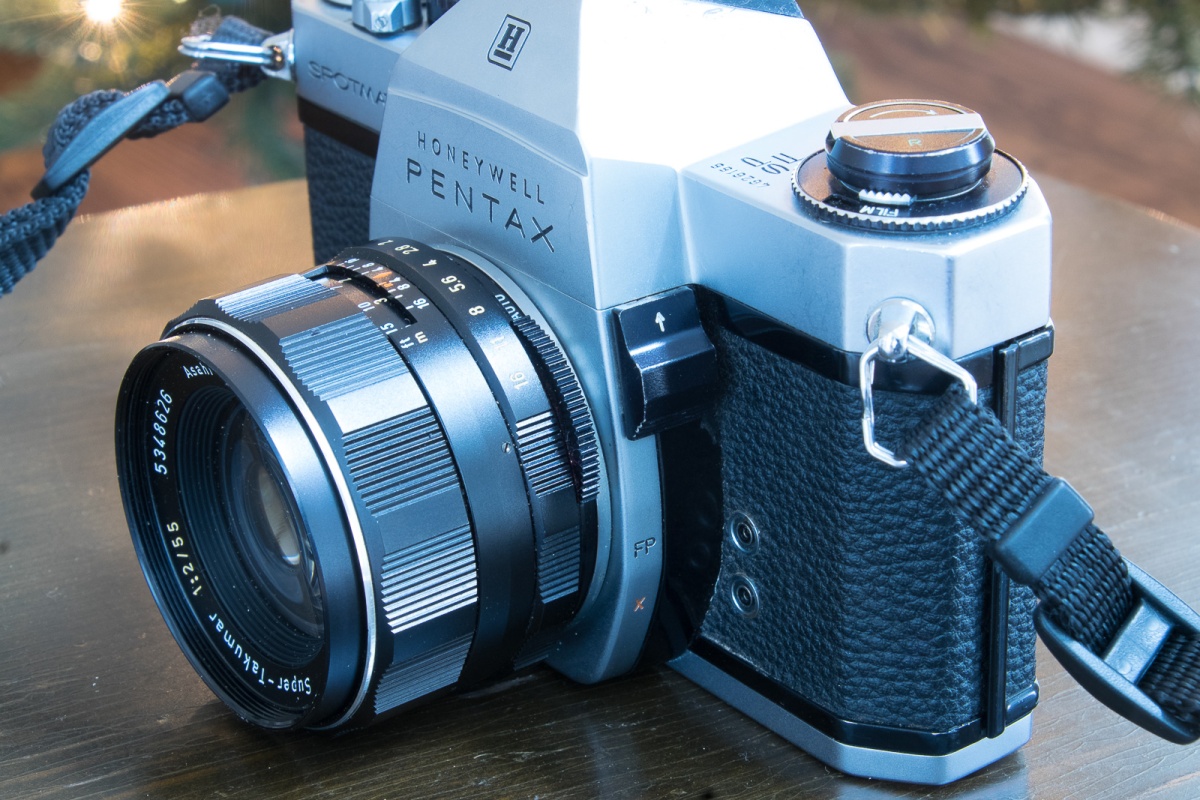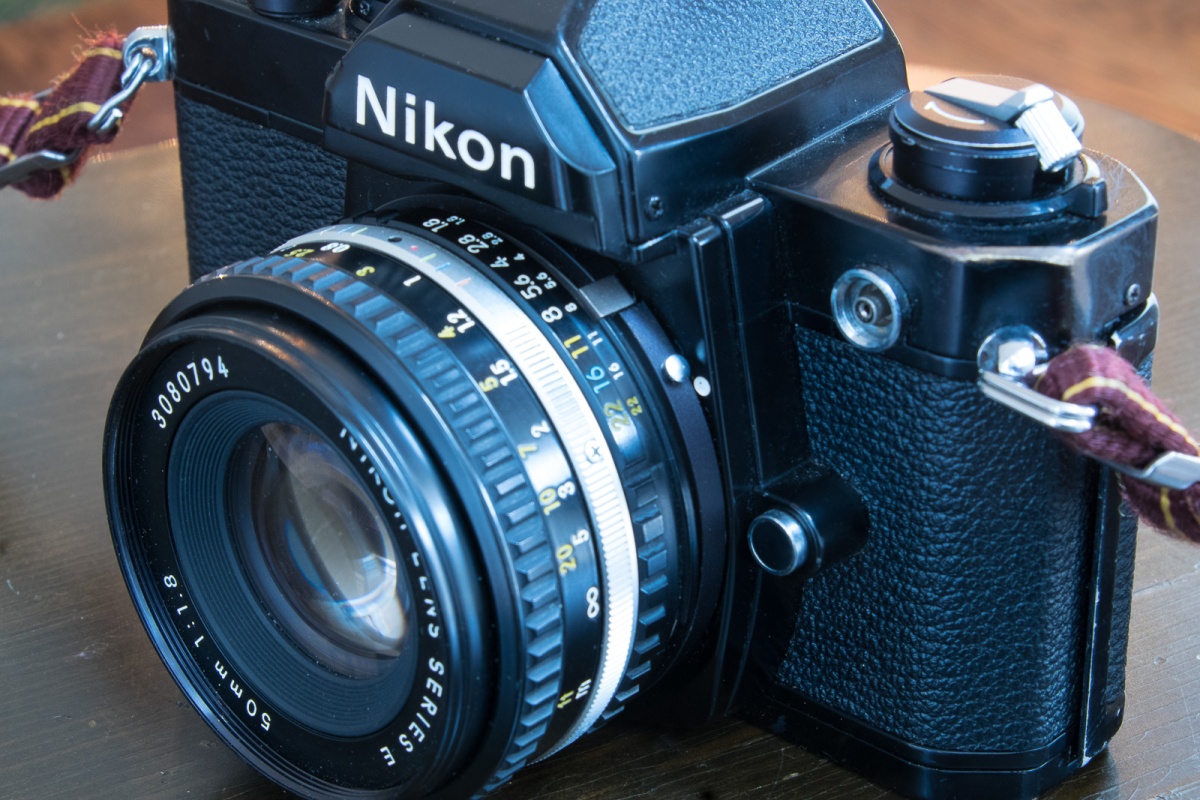The Pentax Spotmatic F and the Nikon FM were probably never on the shelves of photo equipment stores at the same time – when Nikon launched the FM in 1977, Pentax had stopped selling their Spotmatic line of cameras and their m42 screw mount Takumar lenses one year earlier, and were promoting the more compact MX (semi-auto) and ME (automatic) SLRs and their new bayonet lens mount instead.
Logically, the Spotmatic F should be compared with cameras such as the Canon FTb, and the FM with the Pentax MX. But shooting with the Spotmatic F and the FM side by side is a good way to measure the progress made in usability and performance in a just few years.
- Size, Weight, Features and Ergonomics
Looks can be deceiving. The two cameras are roughly the same size and both weight approximately 600g, but the Spotmatic looks taller and feels heavier.
The ergonomics and the organization of the commands are very similar. Both cameras offer semi-automatic exposure – the Spotmatic F needs the SMC Takumar lenses (sold after 1971) to offer full aperture metering, while the FM needs Nikkor AI lenses (sold after 1977) or older lenses modified for Aperture Indexing to provide the same capability.

The shutter of the FM has metallic blades traveling vertically, while the SPF uses a conventional horizontal textile shutter, with a slower electronic flash sync speed (1/60 sec instead of 1/125 sec), and – in my experience at least – a more questionable reliability after a few decades of use.
Lastly, the FM can be equipped with a motor drive, which enables continuous film advance at 3.5 frames per second.

- Viewfinder
That’s where the progress made in a few years is the most…visible. The focusing screen of the FM has a much finer grain, it’s significantly more luminous, and thanks to the combination of a split screen telemeter and a ring of bright micro prisms, focusing is much easier and therefore faster than on the Spotmatic.
The viewfinder of the FM is also more informative – it shows the selected aperture and shutter speed.

On the other hand, I could not have imagined that getting the focus right on the Spotmatic F would require such an effort – even with relatively luminous lenses – the focusing screen is dark, and there is no split screen telemeter to help the photographer when the micro-prism ring is not working. Cameras from the late seventies-early eighties are so much better in that regard – that alone is a reason to shoot with the Nikon FM rather than with the Spotmatic.

- Metering system
The metering system of the Spotmatic F is derived from the first Spotmatic, and like almost all the cameras from the late sixties and early seventies, it’s build around a CdS cell and communicates the exposure value to the photographer with the needle of a galvanometer. CdS cells tend to react slowly to changing lighting conditions (they have memory) and the needle of the Spotmatic is not very precise. Move the aperture ring one stop up or one stop down, and the needle hardly moves. It’s accurate enough for negatives. Not sure it would be precise enough for slide film.
The Nikon FM has a much faster GASP cell (they were all the rage in the late seventies, they were supposed to be better than Silicium cells – the Pentax MX had such a cell too). The right exposure is communicated to the photographer through a set of three red LEDs. The setup is very reactive, and more accurate than the needle of the Spotmatic F.

- Battery
The Spotmatic F still came with Mercury batteries (which have been outlawed in the western world for decades). But it’s very tolerant with the non-Mercury-based replacement batteries available today in every drugstore. The FM works with conventional 1.5v Silver Oxide batteries. They also are widely available.

- Reliability
The Spotmatics are easy to repair – there are still a few specialists who can service them in the US, and based on my personal experience, they’re not going to be out of work any time soon: it seems that the Spotmatics need more tender love and care than more recent cameras. On the other hand, the FM inherited from the robustness and reliability of its older brothers in the Nikon family. Even if it was not considered a “pro” camera in its heyday, it was very often used by professional photographers (war correspondents in particular), as their primary cameras when light, compact and very solid gear was needed, or as a backup camera – in case their big Nikon F2 (or later F3) got into trouble.

- Scarcity and price
Both cameras belonged to the best selling category of their time – semi-automatic exposure SLRs designed for enthusiast amateurs and professional photographers, they were sold by leading manufacturers with a wide distribution network, and hundreds of thousands (Spotmatic F) or even millions (Nikon FM) were manufactured. Lots of them have survived. The Spotmatic F is older, and finding a good copy is more difficult than locating a good FM. There is relatively little demand for the FM (less than for the more recent FM2 with its 1/4000 sec shutter or for the Cosina-manufactured FM10) and supply visibly exceeds demand, which reflects on prices: the FM tends to be cheaper than the Spotmatic F on eBay ($25.00 vs $50.00 for a camera in working condition).

- Lens mount and lenses
The Takumar lenses of the Spotmatic have an excellent, and in my experience, deserved reputation. The “entry level” 55mm lens I used with the Spotmatic F produces contrasty pictures, and the older Super-Takumar 35mm f/2 produces creamy pictures with a fabulous bokeh (it also works very well with mirrorless cameras).

Takumar lenses with the m42 screw mount are abundant on the second hand market, as are third party lenses – but they have to be operated stopped down. Full aperture metering is only possible with the more recent (1971-1975) S-M-C Takumar lenses with their modified m42 lens mount (they can easily be found on the second hand market), but there is next to no offer from third party vendors.Only Tamron seems to have offered lenses supporting full aperture metering on the Spotmatic F. I’ve tried a 28mm f/2.5 wide angle and a 35-70mm f/4 Tamron Adaptall lens, and they both seem to lack contrast compared to Pentax or Nikon original lenses.
The Nikon FM was launched the same year as the “AI” version of the Nikon F bayonet mount, and as usual with Nikon, some level of compatibility exists with prior and subsequent versions of the lens mount.

- The “FM” is one of the “most compatible” of the Nikon bodies – it’s sometimes called the Rosetta Stone of Nikon cameras- and it can be used (with various restrictions) with lenses made from the very beginning of the F mount (1958) until today: Nikon still have AI manual focus lenses in their catalog, and some of their current auto-focus lenses can also be mounted on the FM, provided they have an aperture ring and a mechanical diaphragm control mechanism.

- The offer of second hand lenses (Nikon branded or compatible) is also abundant.
Conclusion
When working with old cameras, we all place the bar of the required level of performance at different positions – it’s a function of our experience, and of the type of scenes we tend to shoot.
The Spotmatic F, although a very good camera in its own right, is too much of an antique for me. Its base design is rooted in the sixties (if not earlier) – it’s the last evolution of the m42 Pentax line. Focusing is the biggest issue – you really have to pay attention to it, and it slows me down to the point I feel I’ll miss too many opportunities when I shoot mobile subjects. It still has a real usage value (on relatively static subjects) and can draw from a large supply of very good lenses, but it’s an antique first and foremost.

Only 4 years younger, the Nikon – although not that different on paper – feels like a more modern camera (lower profile, much better focusing screen, more precise exposure determination). I expect it to be more solid and more reliable too. Like the SPF, the FM is compatible with earlier versions of the brand’s lens mount, but unlike the Pentax, it’s also compatible with the manual focus and with some of the auto-focus lenses still sold by Nikon today.

When kids ask me to let them use an old camera to learn the basics of photography or for an art project at school, I pick the FM with a Nikkor E Series lens – it’s a cheap and very efficient combo and I’m confident they won’t break it.
And the FM – along with its aperture-preferred auto-exposure sibling the Nikon FE2 – is also the camera I bring with me when I need a break from modern, computerized digital cameras – without sacrifying the results.
One last word: the Nikon FM10 has very little in common with the rest of the FM and FE series – it’s a camera manufactured by Cosina, at a time when all manufacturers believed they needed a sub $150.00 manual focus/semi-auto SLR in their product line. The FM10 shares its chassis and its kit lens (except for the lens mount, of course) with the Olympus OM-2000 and with other cameras manufactured by Cosina, and is not a “true” Nikon.
